The Best Bug Out Bag
Bugging Out, Driving, Riding, Cycling, or Walking
In a real bugout situation, the chances are high that you will be walking. I know a lot of people envision themselves bugging out in their cars. Be it 4 wheel drives, or mobile homes, this will most likely not be the case. Which is why choosing The Best Bug Out Bag for your situation is vital. I was unlucky enough to have been in Asia during the 2004 tsunami. And in Zagreb during the earthquake of 22 March 2020. In a bugout situation, expect to walk. A bike or motorcycle is an option if the traffic jams aren’t too bad. But be prepared to walk, it will most likely be your main form of transportation.
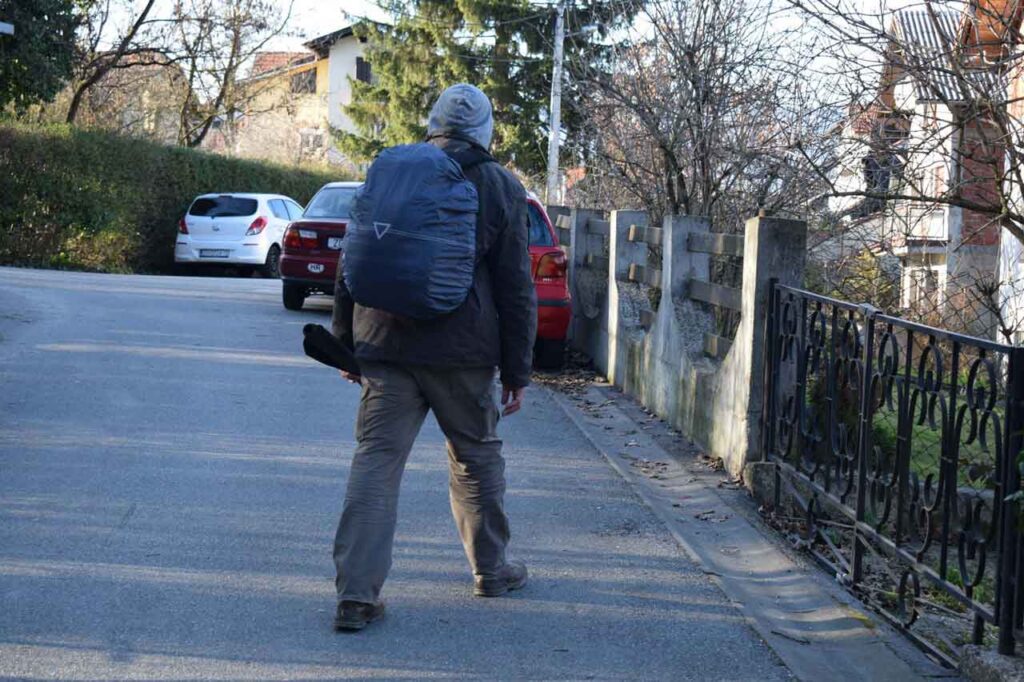
What Is Best Bug Out Bag?
Choosing the best bugout bag is a matter of preference. There are 100’s of good bags to choose from, you should choose one that suits you. In the same way, there is no perfect list of items that go into a bugout bag. The contents of bugout bags are as varied as the contents of a person’s home. There are however some basic items that every bug-out bag should have. So the bag that you choose must be able to at least contain those basic items. Have a look at the Bugout Bag Checklist if you don’t know where to start.
Other than the basic items, whatever goes into a bugout bag is up to the individual. It is based on their skillset, environment, budget, and personal needs.
For example, you would not want to carry winter gear if you live on a tropical island or carry medical equipment you don’t know how to use.
How Many Days Should A Bugout Bag Last?
Most bugout bags are meant to provide you with the essentials to survive for 72 hours in an emergency situation. This is in my opinion a misnomer. Yes.. a 72-hour bag should contain everything you need for 3 days. But when it comes to surviving, in reality, it “should” be sufficient for longer than that. Albeit not in comfort. I have seen people carry inflatable pillows in their bug out bag, that is a serious waste of space. Most 72 hour bags are 35 to 55-liter bags depending on the brand and model of the bag.
How Heavy Should My Empty Bag Weigh?
Weight: Some bags are surprisingly heavy, even while empty. Generally the more durable the bag the heavier it will be. Add in the weight of your gear. And you may end up with a bag you are unable to bug out with. Remember that in a SHTF situation there is a high probability that you will be on foot. As with any decision when buying a survival piece of gear. There are compromises you will have to make. Weight for durability, the price for quality, discretion over tactical benefits.
Choosing The Best Most Durable Bug Out Bag
Build Quality and Durability: The lighter bags are usually not as durable. Tactical or military-style bags are generally the toughest bags on the market (if you choose a reputable brand of course). A good tactical bag will have excellent stitching often varying the angle of stitches so as to prevent stress bursting the seams. A decent warranty and customer service, extra stitching on stress points, good solid YKK zippers, stronger buckles, compression straps.
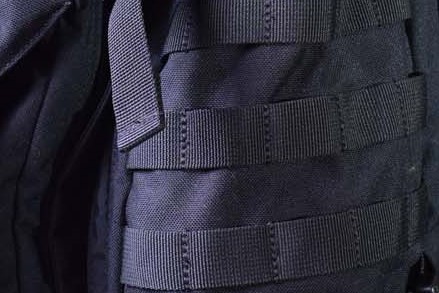
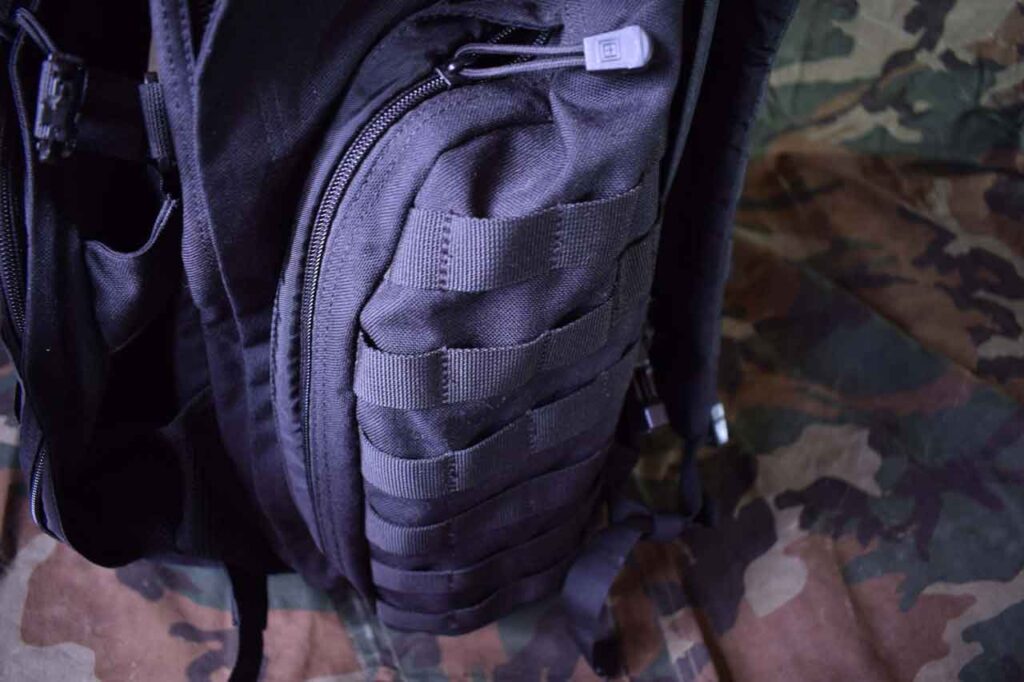
What is a Denier?
Denier is a way of measuring the thickness of the fibers in the fabric. For example, a single strand of silk would be approximately 1 denier. In the past tactical bags with the highest denier were considered premium quality. The problem was the weight of the bags increased quite a bit with the heavier material. Generally, nowadays most preppers will settle for a 500 to 1000 denier bag. These bags will take a lot of abuse and are generally considered hard-use bags.
What Denier Should My Bugout Bag Be?
What Denier should my bugout bag be? That would depend on if you are going for a hikers bag or a tactical bag as your bugout bag. A hikers bag such as those produced by Deuter, Kelty, or Osprey. Well for those bags I would recommend a denier of 420D to 600D. For Tactical bags, I would recommend 500D to 1050D, although be warned there will be a bit of weight difference.
What Is The Best Color For A Bugout Bag?
What color is best for a bug-out bag? Avoid camo of any type. If you need to blend into the forest, desert, or snowy winter landscape, you can buy a bag cover. It will not only protect your bag but also allow it to blend in. Don’t get bright colorful bags, in most SHTF situations, you don’t want to stand out from the crowd. I would recommend that your bugout bag, be a discrete color. Black, green, brown, once you get out of an urban, city setting. You can choose to put on the bag cover of your choice.
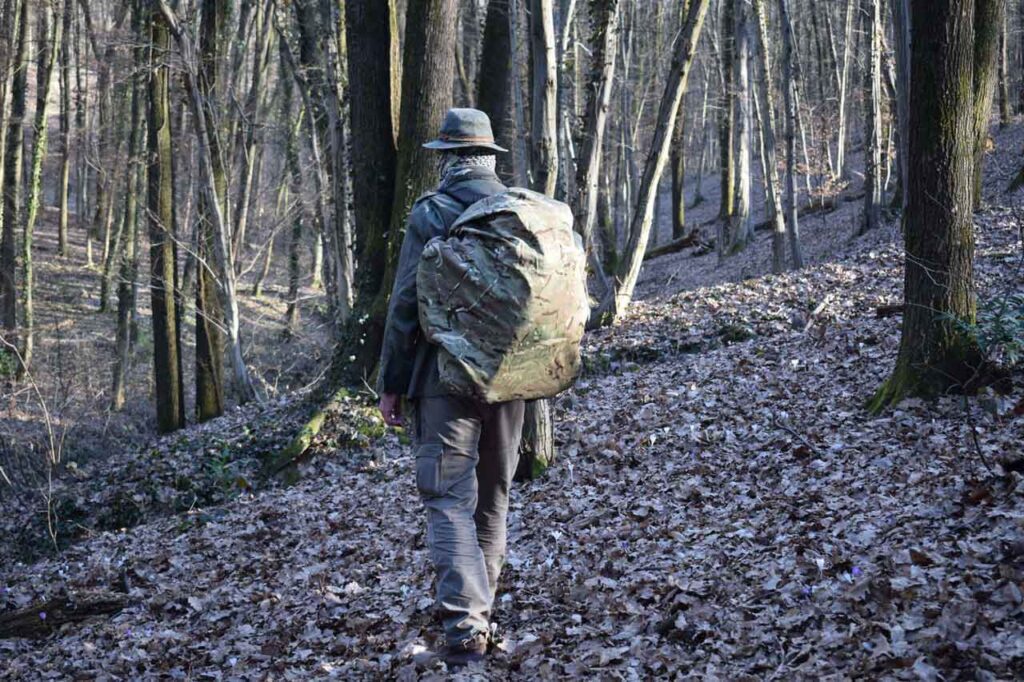
The external appearance of a bugout bag is a matter of much debate, it’s the grey man vs the tactical man debate, many preppers survivalists are choosing more discrete designs veering away from bags that appear too tactical in appearance as they feel it will attract too much undue attention, although appearance will depend on location and environment,

Bug Out Bag Rain Covers
for example, walking through a business district carrying an Alice Pack style bug out bag will stand out, a person walking through the boondocks wearing a suit and briefcase would be just as conspicuous. Choose a bag that fits into your surroundings or as an alternative, you can always choose to camouflage your bag by choosing bag covers that will blend in, Simple backpack rain covers can mask a tactical styled bag and make it appear to be an everyday style rucksack.
How Big Should My Bug Out Bag Be?
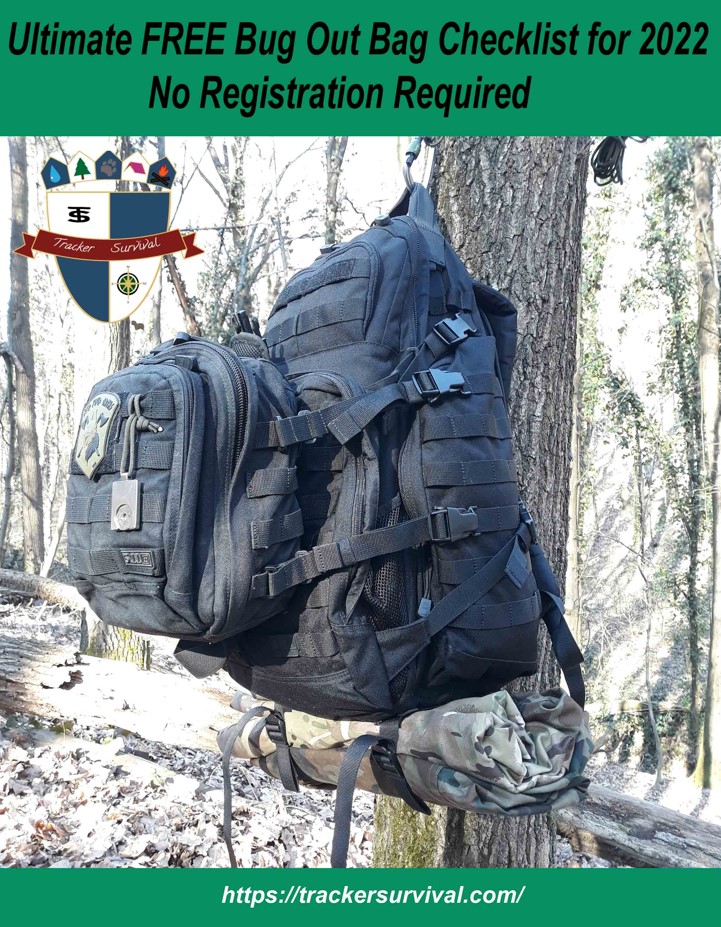
Capacity: This can get a little bit controversial, there are a lot of theories as to how much a bug out bag should weigh, with formulas such as 10% to 25% of a persons body weight, some people throw out numbers such as 15 pounds or 25 pounds, others use figures they get from the military who often carry 45 to 100 pounds of gear. I have seen bug-out bags that weigh 80 pounds and the person who stocked the bag couldn’t carry it for more than 1 km, after which it wasn’t a bug-out bag, but a bug-out anchor.
Fitness Level Is An Important Factor
The size and capacity of a bug-out bag should be determined by the size and fitness level of the person carrying the bag. Expect to walk for 10s of kilometers carrying your BOB (bug out bag). There is no point buying a 75L bag if you can’t carry it. I can tell you my preferred bag has a capacity of 55L, to me, this is sufficient space to pack all the things I need in case of a bug-out situation, with a little bit of space free for extras.
What is the Most Comfortable Bugout Bag?
Comfort: This is important to those who were not in the military and are unused to big bulky uncomfortable overstuffed bags. A little bit of discomfort is to be expected, you are after all lugging around a lot of gear that could potentially save your life. That doesn’t mean it should be so uncomfortable that the bag on your back is all you can think of. So before buying a backpack, try it on. Check it sits properly on your back, that it has a waist strap and sternum strap, that it does not pull away from your back. If a bag company claims the bag is so comfortable that you won’t even feel it, then you know they are pulling your leg.
Should I Get A Bugout Bag With Pals Webbing On It?
Yes, the pros outweigh the cons in my opinion, it is true that pals webbing on bags make them look tactical, which would make you stand out in a crowd (this can easily be solved with a backpack cover), think about the versatility of having pals webbing on your bag, you can carry your gear in Molle pouches in your bag, if you need more internal space, take them out and attach them to the external pals webbing, this will free up internal space, thereby expanding the carrying capacity of your bag. It helps with organization and expansion of carrying capacity.
Waterproof Bugout Bags
Water resistance: A bugout bag should be at the least water-resistant in case of light rain, few are fully waterproof.
It is recommended that you have an external rain cover for your bag, a few dry bags, Ziploc bags, and heavy-duty garbage bags in your BOB. Some people do Spray DWR (durable water repellent) on their bags, I prefer and recommend using the method above, dry bags, backpack rain covers and in a pinch, garbage bags covering my bag.
Best Bug Out Bag
The best bugout bag in my opinion is the 5.11 Rush 72. It hits all the criteria that I wanted.
Extremely durable,
5.11 Rush series are made of a 1050 denier material, I have been using the Rush 72 for hiking, bushcraft, camping, and traveling for the last 5 years, it has traveled to half a dozen countries and on numerous outings, it looks pretty much brand new, and let me just say I am not a delicate kinda guy.
Perfect capacity
Weirdly enough for the gear I chose to pack in my bugout bag, the 55l capacity seems larger, probably due to the great design. It is marketed as a 72-hour bag, but I have used it as a week-long camping bag and it more than fit all my gear in it. I have also used it as a traveling bag for a 6-month work trip. Worked fine for that as well. Just keep in mind I am a minimalist, so I pack only the essentials of what I need.
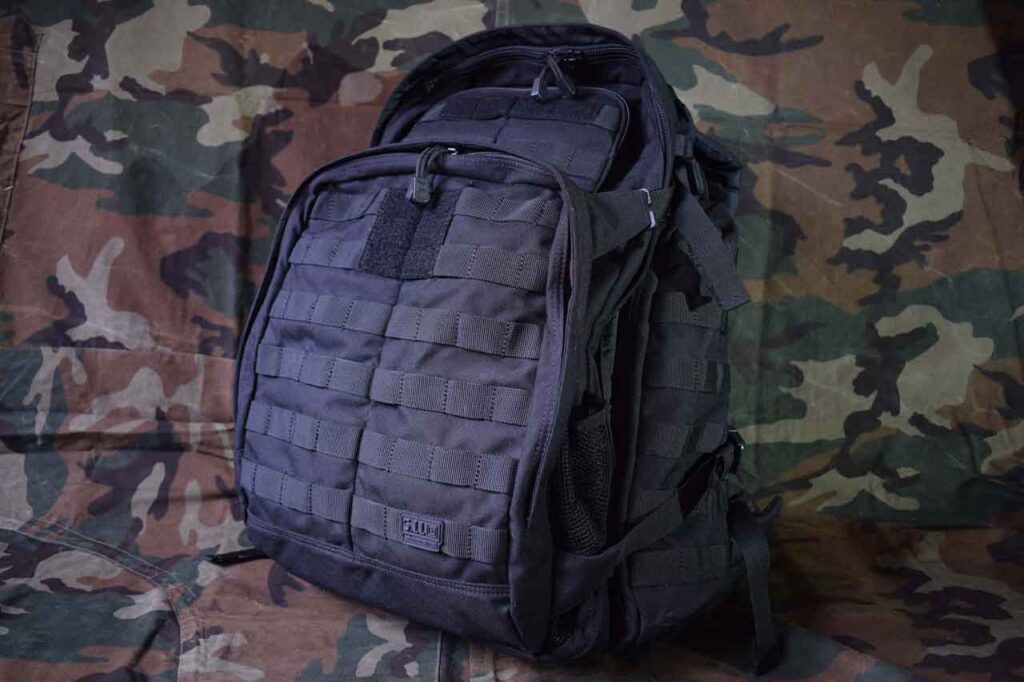
DWR Treatment
It is DWR (durable weather resistant) treated, light rain just runs off it. Just don’t expect your gear to be bone dry in the pouring rain, water will seep through. There are a couple of drainage holes at the bottom of the bag. But that doesn’t help your situation if all your stuff gets wet. I pack my clothes in dry compression sacks (Sea to Summit EVent) and my other stuff in Ziploc or plastic bags. I also have a backpack rain cover. Keeping your gear dry is essential.
The 5.11 Rush 72 is Molle compatible, has PALS webbing on the front, sides, and bottom of the bag. I pack most of my stuff inside the bag. I do strap my tarp, sleeping bag, a couple of carabiners, and a water bottle pouch on the exterior PALS webbing.
Waist And Sternum Straps
Waist and sternum strap. Sits comfortably on my hips and doesn’t drag on my shoulders. Essential for a bag of this size, without them the weight would sit squarely on your shoulders. For short hikes, that’s fine, for long ones, you will be cussing all the way there and back. I do have a complaint about the sternum strap on the 5.11 24 and 72, they both come off quite easily, I have nearly lost mine on a couple of occasions. When taking the bag off in winter, the sternum straps tend to get snagged on my jacket. This was easily fixed
Clamshell opening of the main compartment, and the admin compartment. Accessing the bag is so danged convenient.
How Much Organization Should A Bugout Bag Have?
When you are traveling for business or if you are on a vacation, you can chuck everything into a bag and unpack when you reach your destination, a bugout bag is different, you need it to have a decent number of pockets for organization, you do not want to have to rummage around in your bag when you need something, you want to be able to find the things you need quickly.
Don’t get a bag that has just one large compartment, or one that has a dozen small ones, you need a good mix of organizational ability, one of two large compartments, a few small ones, and a couple of pockets to slip little items in.
Multiple pockets for organizing
The 5.11 Rush 72 has a dump pouch that you can stuff a jacket or any other bulky item that you need quick access to. Initially, I was not a fan. If I am not mistaken this was designed for carrying a helmet, as I used the bag, I found myself stuffing things in there that I would usually have to hang on myself, or put in the bag (eg: jackets, sweaters, caps, shemagh). It does tend to make the admin section of the bag sag a little forward if the compression straps are not properly tightened, but if done right, it works great.
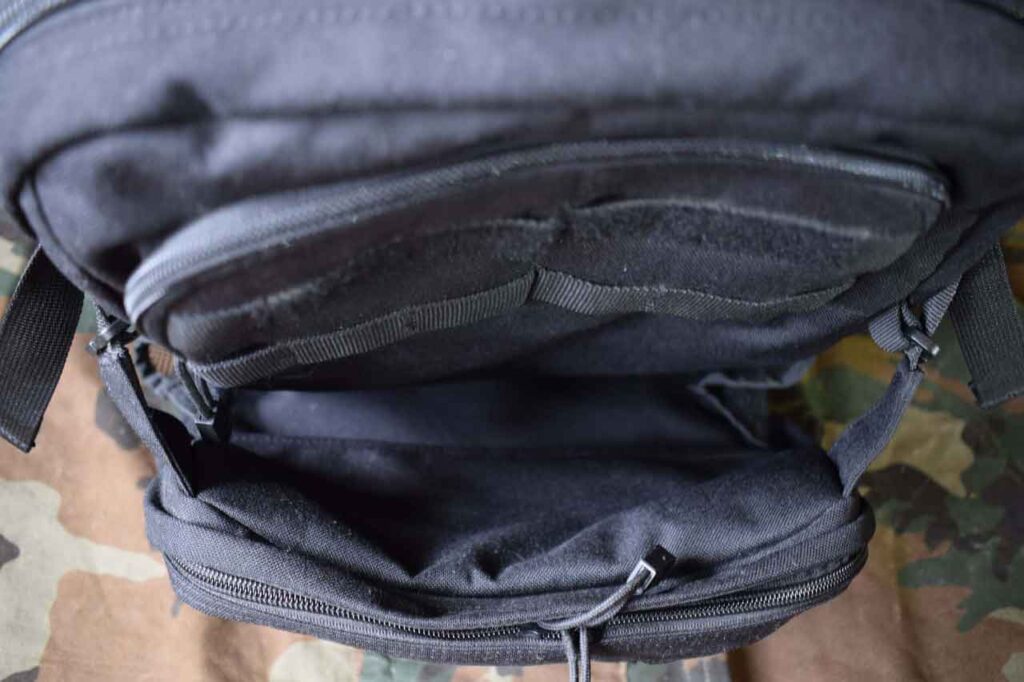
Reasonably priced (it’s a midrange bag). Not the cheapest bag on the market, but the best value for the price. This is one of those bags you are going to be using for a long time. Without any fear of it failing on you.
I didn’t go for the camo, black seemed to be more discrete, I have traveled with this bag in Asia and Europe, and no one batted an eye.
5.11 Rush 72 Tier System
The 5.11 Rush series also has an interesting ability to clip on another bag of the same series using their Rush Tier System. This works well with the 5.11 Moab bags, but in my opinion, is too bulky with any of the other bags. I tried attaching the Rush 24 to the Rush 72 and it stuck out so far on my back it was like carrying 2 boxes taped together, unwieldy, and very uncomfortable. The 5.11 Moab 6 on the other hand fit perfectly and was hardly noticeable. I do wish the sling was removable on the Moab 6, so it wouldn’t bunch up, but that is acceptable for the convenience of being able to haul 2 bags simultaneously.
Use What You Have
Don’t misunderstand me, having a great bag is important, but the scenario is a SHTF situation, and if a high-end bag is out of your budget, then use whatever you have available, a school bag, messenger bag, any comfortable to carry bag you have handy.
In the pioneering days, people used home-sewn bags, pouches, sling packs, hand-sewn baskets, and even blankets folded up and jury-rigged onto a makeshift wooden frame.
So while you probably won’t have to resort to the extremes of the pioneering days, get a bag and prepare yourself for an emergency, a B.O.B should be within most peoples budget. Keep in mind, something is always better than nothing.